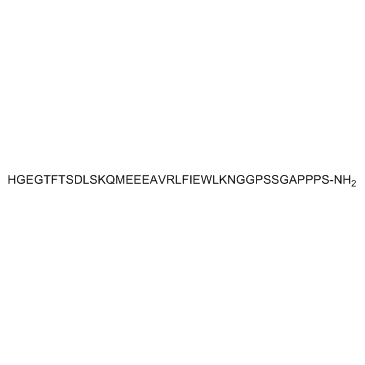141758-74-9
| Name | exendin-4 |
|---|---|
| Synonyms |
MFCD00240171
Exenatide L-histidylglycyl-L-glutamylglycyl-L-threonyl-L-phenylalanyl-L-threonyl-L-seryl-L-aspartyl-L-leucyl-L-seryl-L-lysyl-L-glutaminyl-L-methionyl-L-glutamyl-L-glutamyl-L-glutamyl-L-alanyl-L-valyl-L-arginyl-L-leucyl-L-phenylalanyl-L-isoleucyl-L-glutamyl-L-tryptophyl-L-leucyl-L-lysyl-L-asparaginylglycylglycyl-L-prolyl-L-seryl-L-serylglycyl-L-alanyl-L-prolyl-L-prolyl-L-prolyl-L-serinamide Exendin-4 |
| Description | Exendin-4, a 39 amino acid peptide, is a long-acting glucagon-like peptide-1 receptor agonist with an IC50 of 3.22 nM. Sequence: His-Gly-Glu-Gly-Thr-Phe-Thr-Ser-Asp-Leu-Ser-Lys-Gln-Met-Glu-Glu-Glu-Ala-Val-Arg-Leu-Phe-Ile-Glu-Trp-Leu-Lys-Asn-Gly-Gly-Pro-Ser-Ser-Gly-Ala-Pro-Pro-Pro-Ser-NH2. |
|---|---|
| Related Catalog | |
| Target |
IC50: 3.22 nM (glucagon-like peptide-1 receptor)[1] |
| In Vitro | In human umbilical vein endothelial cells, exendin-4 significantly increases NO production, endothelial NO synthase (eNOS) phosphorylation, and GTP cyclohydrolase 1 (GTPCH1) level in a dose-dependent manner[2]. Exendin-4 shows cytotoxic effects to MCF-7 breast cancer cells with IC50 of 5 μM at 48 hour[3]. |
| In Vivo | Both low- and high-dose exendin-4 treatment in ob/ob mice improve serum ALT and reduce serum glucose, insulin levels and calculated HOMA scores compared with control. Exendin-4-treated ob/ob mice sustain a marked reduction in the net weight gain in the final 4 weeks of the study period[4]. Animals treated with exendin-4 have more pancreatic acinar inflammation, more pyknotic nuclei and weigh significantly less than control rats. Exendin-4 treatment is associated with lower insulin and leptin levels as well as lower HOMA values in rats[5]. Exenatide causes dose-dependent relaxation of rat thoracic aorta, which is evoked via the GLP-1 receptor and is mediated mainly by H2S but also by NO and CO[6]. |
| Animal Admin | Rats: 20 Sprague-Dawley male rats, ten of which are treated with exendin-4 (10 μg/kg) and ten of which are used as controls. The study period is 75 days. Serum and pancreatic tissue are removed for biochemical and histological study. Blood glucose, amylase, lipase, insulin and adipocytokines are compared between the two groups[5]. Mice: The exendin-4 treatment groups are treated with 10 μg/kg every 24 hours for the first 14 days. This treatment is the induction phase. Respective control mice (lean and ob/ob) receive saline every 24 hours. After 14 days Exendin-4-treated mice are randomly divided into two groups: one group receives high dose exendin-4 (20 μg/kg) every 12 hours, while the second group continues with low dose exendin-4 (10 μg/kg) every 12 hours. The control mice continue to receive saline every 12 hours. The mice are weighed daily for the 60-day treatment period[4]. |
| References |
| Molecular Formula | C184H282N50O60S |
|---|---|
| Molecular Weight | 4186.57000 |
| Exact Mass | 4184.03000 |
| PSA | 1775.05000 |
| Personal Protective Equipment | Eyeshields;Gloves;type N95 (US);type P1 (EN143) respirator filter |
|---|---|
| Hazard Codes | Xi |
| RIDADR | NONH for all modes of transport |
| WGK Germany | 3 |


